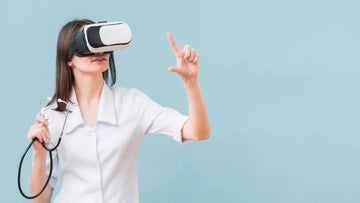Menstrual education has many challenges, like stigma, myths, and a lack of correct facts. But many women do not know this, so educating young people about menstruation helps break myths, normalize conversations, and encourage better hygiene practices. Technology improves menstrual awareness by making information accessible, interactive, and engaging. Digital platforms, mobile apps, and Virtual Reality (VR) simulations provide immersive learning experiences, allowing individuals to understand menstruation scientifically and emotionally. Virtual reality for menstrual education, in particular, enhances awareness by offering realistic, stigma-free education, enabling users to experience menstrual cycles virtually. Integrating technology into menstrual education can empower individuals with accurate knowledge, encourage open discussions, and create a society where menstruation is understood without fear or shame.
What is Virtual Reality and How Does It Work?
Virtual reality (VR) is an advanced technology that immerses users into a fake, interactive environment, making learning more engaging and experienced. By using a VR headset, individuals can detect lifelong digital spaces, interact with objects, and get knowledge on their hands. In virtual reality for menstrual education, users can imagine the female reproductive system in 3D, see the menstrual cycle in action, and learn the necessary hygiene practices. This groundbreaking approach eliminates stigma, promotes deep understanding, and converts menstrual health education into an interactive experience.
Why is Virtual Reality Perfect for Menstrual Education?
Virtual reality for menstrual education makes it more comfortable by making it a safe place where students can learn without embarrassment. Many people feel shy or have a strange period, but VR lets them know privately and at their own pace. Emergent experience makes the menstrual cycle more attractive by showing it clearly, in a 3D way, instead of only reading it.
With interactive simulation, users can see how the body changes, observe hygiene practice routines, and experience real-life scenarios. This attitude helps students understand and remember information better. By making menstrual education more visual, attractive, and stigma-free, we ensure that more people gain the knowledge they need to deal with menstruation.
How is Virtual Reality Being Used for Menstrual Education?
3D Menstrual Cycle Simulations
Virtual reality for menstrual education helps people see and understand the menstrual cycle in a 3D world. It clearly and interactively shows each phase, from ovulation to menstruation. This makes it easy to learn and helps users remember important details of how the body works.
Virtual Workshops & Training Modules
VR workshops provide a fun and comfortable way for students, parents, and teachers to learn about the period. These programs include specialist talks, quizzes, and activities that make learning about the period simple and free from embarrassment, helping everyone gain the right knowledge.
Interactive Problem-Solving Scenarios
VR lets users experience real-life situations like leaks, period cramps, or social stigma. These activities create self-confidence and teach practical solutions so people can handle menstruation more clearly and comfortably.
Virtual Reality-based hygiene and product use training
With VR, users can learn how to use sanitary pads, tampons, menstrual cups, and environmentally friendly options. This hands-on training helps them understand the right hygiene and choose the best menstrual product for their needs in a stress-free environment.
Virtual Reality for Period Awareness
VR helps boys, parents, and communities understand what menstruation seems to experience and the challenges associated with the period. These simulations break taboos and encourage open discussions, and menstruation creates a supportive attitude to health, making society more understandable and inclusive.
Challenges in Using Virtual Reality for Period Awareness
Accessibility Issues: The High Cost of VR Equipment
VR technology can be expensive, making it difficult for schools and organizations to afford. Many communities, especially in rural areas, lack access to the necessary devices. Lower-cost alternatives and widespread adoption are needed to make VR menstrual education more inclusive.
Cultural Barriers: Breaking Stigma
Menstruation remains a sensitive topic in most cultures, and it is not easy to introduce VR-based education. Stigma and traditional beliefs get in the way of acceptance. Raising awareness, involving community leaders, and normalizing to overcome resistance and encourage menstrual health education.
Localized VR for Menstrual Education
Menstrual practices and beliefs vary across cultures, requiring VR content to be tailored to different regions. Language barriers, local customs, and product availability must be considered to ensure the lessons are relatable, practical, and effective for diverse communities.
How to Bring VR Menstrual Education to More People?
Enlarging virtual reality for menstrual education involves coordinating with schools and governments to add it to curriculums so everyone can access it. Community-based VR workshops can reach underserved areas, offering experiential learning in secure environments. Pushing tech industries to invest in educational VR software can reduce the cost of the technology and increase its accessibility. By reducing costs, improving distribution, and enhancing awareness, VR may be the powerful tool menstrual education needs to end myths and give people the knowledge they need about their bodies.
Conclusion
Virtual reality for menstrual education transforms menstrual education by making learning experiential, interactive, and myth-free. Unlike traditional methods, VR offers a secure environment where people may know about menstruation without shame and be able to disrupt entrenched taboos. VR provides interactive simulations, hands-on hygiene training, and empathy-experiential learning, making menstrual health education accessible to everyone. Innovation can help bring periods to the mainstream and overcome cultural stigmas. As technology continues to evolve, a future is hoped to be planned where menstrual education is inclusive, empowering, and accessible to everyone everywhere. Expanding VR in schools, communities, and businesses ensures more people gain the knowledge and confidence to handle menstruation with dignity.
FAQ’s
Why Is Virtual Reality Successful?
VR is successful as it gives immersive, interactive experiences that enhance gaining knowledge of, engagement, and retention. It creates realistic simulations, permitting customers to practice talents thoroughly and efficaciously, making it valuable in training, education, and various industries.
What Is The Role Of Virtual Reality In Medical Education?
Virtual reality for menstrual education helps medical students practice procedures, understand anatomy, and simulate real-life medical scenarios without risks. It enhances hands-on learning, improves decision-making abilities, and provides a controlled environment for training, ultimately leading to better patient care and medical expertise.
How Is Virtual Reality Used For Menstrual Education?
VR enhances education by making complex concepts easier to understand through 3D models, simulations, and interactive lessons. It creates engaging science, history, and health studies, enhancing understanding, retention, and pupil participation in learning.
What Is The Future Scope Of Virtual Reality In Education?
The future of virtual reality for menstrual education in schooling includes AI-driven adaptive learning, wider accessibility, and integration with mainstream curriculums. As technology advances, VR will provide customized, cost-effective, and immersive educational experiences, transforming how students learn worldwide.
What Are The Advantages And Disadvantages Of Virtual Reality For Menstrual Education?
Advantages encompass immersive gaining knowledge of, higher engagement, and progressed retention. Disadvantages involve high charges, accessibility troubles, and the potential for over-reliance on technology. While VR enhances education, proper implementation is required to ensure it remains a beneficial and inclusive learning tool.




